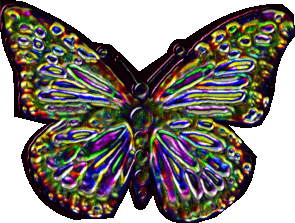
Art, Symbols, Fascination
& The Eternal Love Of The Light
A Retrospective With Silvia Hartmann by Nicola
Quinn
V: Honestly Following The White Rabbit All The Way To The Light
NQ: These symbol paintings are so fascinating and so powerful, it
is difficult to imagine what could be “beyond symbol paintings”.
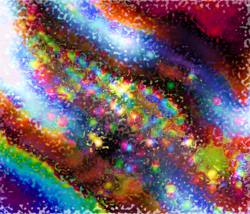 SFX: [laughs] Yes, they’re a bit of a last word on just about any
topic ... or so it seems ...
SFX: [laughs] Yes, they’re a bit of a last word on just about any
topic ... or so it seems ...
NQ: So what caused this current exhibition and what was the idea
behind it? Has this to do with you having an idea and following it?
SFX: Yes, and the reason I follow it is because they fascinate
me. It sets me on fire, I need to follow it, I *must* follow it.
It’s not just a vague thought of, “Perhaps I could chop this tree
down ...”
It’s like, “OH MY GOD!!!! If I was to chop this tree down, THEN I
could – dot, dot, dot!”
NQ: So then, what are these new paintings?
SFX: I think we have got to be honest here. We have got to take
the clues into consideration. On the 23rd of August is my 46th
birthday. The things that I do, I do them for personal development.
I don’t set about to change the world or heal anybody. I don’t even
set out to heal myself!
I just sit there and cry and my hand does some thing.
I’m not in a laboratory and say, “Well, I am depressed so now I
need some art therapy ...”
It doesn’t work like that.
It’s as though there is this part of me that has this agenda of
healing or of evolution, I don’t know, and it gives me these ideas
to nudge me into a certain direction – and if I follow that, I will
be rewarded in some way.
NQ: So you have some trust that in the end, it will be
worthwhile?
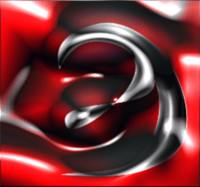 SFX: Yes. If there is some fascination that happens, then I will
follow that immediately. It is exciting! I will follow that, I will
heed it and I will also protect it. If some person comes along and
says, “We’re going to the theatre tonight!” I will say, “Sorry but I
can’t go, I have to chase a light spot around my ceiling tonight.”
SFX: Yes. If there is some fascination that happens, then I will
follow that immediately. It is exciting! I will follow that, I will
heed it and I will also protect it. If some person comes along and
says, “We’re going to the theatre tonight!” I will say, “Sorry but I
can’t go, I have to chase a light spot around my ceiling tonight.”
I guess that’s why I get rewarded the way I do, because I will do
that, I will protect the fascination.
I will protect it from the muppety stuff, being somewhere on
time, supposed to be being somewhere else or having planned
something else. That’s not important. But chasing a light spot round
the ceiling that leads to Art Solutions and For You, A Star, that’s
important to me.
It all starts with a fascination and a curiosity, and I know that
if I follow that there will be a reward at the end of the day.
I’ve done this often enough by know to trust in that.
Most people don’t do that. They have a fascination but they don’t
follow that, so they don’t get rewarded with the amazing breakout at
the end, where it shifts.
Ok, so chasing a light spot around the ceiling is weird.
NQ: It’s like that they don’t know what that could be about and
they don’t know if it’s going to be worth their while.
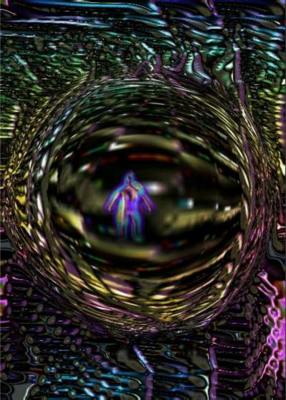 SFX: Right. But the whole Art Solutions thing is definitely worth
it, it’s even worth a lot of money. You could make a career out of
teaching this, with ease.
SFX: Right. But the whole Art Solutions thing is definitely worth
it, it’s even worth a lot of money. You could make a career out of
teaching this, with ease.
It’s one hell of a reward on every level. You could get acclaim
for it, even find new lovers as you’re touring the country with
this. The rewards are there, but you need to follow the little
inspirations. If you don’t do that, you don’t get the big rewards at
the end.
Now with this new exhibition, I have some serious contortions
because I didn’t go to art school. I always say that I can’t draw or
paint. In fact I attended a water colour class the other day and sat
there feeling really bad because they could paint a beach and I
couldn’t.
For the past three years, I’ve been having enormous fun with
Paint Shop Pro and the Flaming Pear products. Plug, plug, plug-in!
I got them for a Christmas present three years ago and I’ve been
playing with them, but computer art isn’t real art, so it doesn’t
count, right. ‘Cause you got to go to some place first and draw
oranges for eight years. Every day.
Graphics design, I guess that’s allowed. But to make a painting,
but it’s from Paint Shop Pro and XaraX, that’s evil. Like putting on
a wig and calling yourself a woman if you’re not.
It’s evil. You just can’t use computer tools to make an image and
call it art.
That’s what I was thinking and feeling, anyway.
Well, so at one point I was working on something and hit the
wrong button, and the image turned into this chaotic mess. But there
was one area on the screen, I’ve got this big screen, which drew my
attention – I was fascinated by it.
Fascination Dot Com!
Aha! said Silvia. I shall lay aside what I thought I was going to
do and instead, follow this fascination.

What I did was something that can’t be done on a real canvas,
which was to enlarge the area on the image which fascinated me until
it filled the entire screen again, using the fractal movement of
zooming in.
When the fascinating area got big, this itself contained another
fascinating area, so I kept moving in and in – until a click
occurred.
That’s close enough.
But it wasn’t quite right yet.
So what I did was to randomly apply a number of different filters
until I got the click to stop – and at that same time, I got the
title of the image delivered and I knew I was done.
In order to save myself from mental misery, I asked myself if I
could replicate this painting if I was to use canvas and brushes and
the answer was yes – easy peasy, lemon squeezy!
Print it on a canvas with an art printer, fill it in, painting by
numbers, and there it would be – completely manifest in the hard.
If you look at the images closely, you can see that they’re not
difficult to paint. They’re easy, actually. And thus, they count as
paintings.
The nice thing about these is that there was no question asked up
front, and I allowed my click partner to decide what we’re doing. So
that wasn’t me asking for help from them, but them showing me
something that THEY might have needed help with?
And there was certainly an occasion when there was a part that
fascinated me but it also appalled me deeply. It reminded me of
something very bad and hideous. I picked it and enlarged it and
there it was, a real scream filling the entire screen, and I put my
hand on the screen and said, “Thank you for showing me this, and
now, let’s make this into something beautiful.”
One of the lovely things with Paint Shop Pro is that the thing
will MELT, and assume a new shape.
You can change the colours and you can change the NATURE of the
thing and morph it on until it is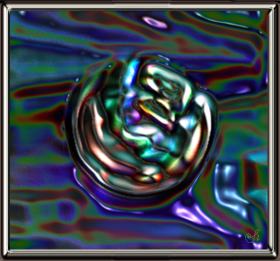 something beautiful.
something beautiful.
They’re not all like that but this one, I really noticed this.
What I also found fascinating is that in doing these pictures in
Paint Shop Pro, I learned such a lot about physical painting.
Because I looked at each one with the view of “How would I do this
for real?”
And I knew how to do that – you’d have to have a certain
background texture, you’d need a couple of layers of glaze, and a
sponge, and a spray, and that’s how you would do it, that’s how you
would get it to look exactly like that.
There are others where there is clearly watercolours with bleach
involved.
It also taught me more respect for colours. We’re talking 256
colours here, that is not a very big paint box. I got a lot of
respect for the fact that we haven’t pushed it hard enough to get
the colours right – you can get them right, it’s just a question of
mixing them up right.
I learned an enormous amount in preparing the pictures for this
exhibition. About structure and texture, and light and colour
interaction, and I had so many new ideas on what to do with an
actual painting.
NQ: You said something to me about also learning what not to do.
SFX: [laughs] Oh yes, the courage thing! After the first four
were finished, the thought occurred to me that pictures are designed
to be seen – that they should be exhibited, that there should be an
exhibition.
So I asked a friend how many pictures you would need for an
exhibition, but before they had a chance to answer, the number “23”
had jumped into my head – 23 pictures for an exhibition on the 23rd
of August.
That made sense and put the idea of the online exhibition in my
head.
So now, we’re in the country of exhibitions and that is what
artists do, and of course, I think I’m not, or I thought I wasn’t,
although it is getting a bit difficult to know now after we went
through the chronology earlier, and as soon as you bring other
people looking at this into it, it changes everything.
NQ: That would be the “looking over your shoulder” problem ...
SFX: Exactly. Now you’ve got all these weird ideas swirling
around in your head about what you’re supposed to do and not
supposed to do, and I noticed particularly with some of the
paintings that I had a major fear of nothingness.
NQ: [laughs] A major fear of nothingness?!
SFX: Yes, like a big yellow blob in the centre of the painting
where there is nothing happening – there’s no texture happening, no
structure happening, no movement, it’s just yellow.
But ... it wanted to be yellow!
I tried to put something clever or meaningful in the middle but
the part of me that wanted this project to happen in the first place
was just not happy, and in the end I got it that you need to have
courage to not put things in, to let it stand as it is, and have it
be just yellow. And if that isn’t enough for you, then go away and
do your own painting! [laughs]
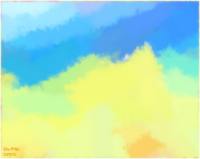 That was quite funny. I didn’t have this problem with the ones
where there’s lots of things happening and you can stand in front of
it and say, “Oooh, that’s interesting, and that’s interesting ...”
But with this space one, I was really concerned, shouldn’t I be
shouting and jumping up and down? I needed courage to *leave it
alone*.
That was quite funny. I didn’t have this problem with the ones
where there’s lots of things happening and you can stand in front of
it and say, “Oooh, that’s interesting, and that’s interesting ...”
But with this space one, I was really concerned, shouldn’t I be
shouting and jumping up and down? I needed courage to *leave it
alone*.
The high end challenge was the painting called Sand & Sea. This
was also the high end challenge to the usual complaint levelled
against abstract art, “Oh my 3 year old nephew could do better than
this! How dare you call yourself an artist!”
Then you have to have the courage to say, “But it wanted to be
just like that and I’ve made it like that, the best I can,” and you
just have to have the courage to leave it there.
And not trying to be clever.
That’s very, very essential. And I do try to be clever!
It was quite hard to not be clever but just be honest.
Honest, I wanted those simple bands of blue and yellow on there.
NQ: Are there any other paintings from this exhibition you would
like to comment on briefly before we go?
SFX: I would just like to mention the last painting that closes
the series.
It is a very slight morph of the details of one of my symbol
paintings, it just has a slight wash over the top, and it is called
The Eternal Love of Light.
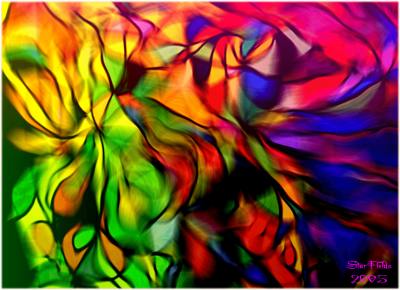
Because at the end of the day, it is light and movement. And
light equals colours. I just love colours and movement.
There’s just nothing on this planet that fascinates me that
deeply.
© N Quinn/S Hartmann 2005

All
Images Copyright Silvia Hartmann Unless Otherwise Stated.
All
Rights Reserved.










